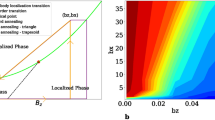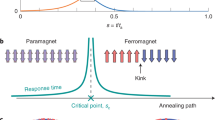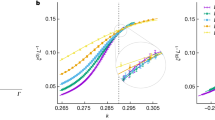Abstract
Experiments on disordered alloys1,2,3 suggest that spin glasses can be brought into low-energy states faster by annealing quantum fluctuations than by conventional thermal annealing. Owing to the importance of spin glasses as a paradigmatic computational testbed, reproducing this phenomenon in a programmable system has remained a central challenge in quantum optimization4,5,6,7,8,9,10,11,12,13. Here we achieve this goal by realizing quantum-critical spin-glass dynamics on thousands of qubits with a superconducting quantum annealer. We first demonstrate quantitative agreement between quantum annealing and time evolution of the Schrödinger equation in small spin glasses. We then measure dynamics in three-dimensional spin glasses on thousands of qubits, for which classical simulation of many-body quantum dynamics is intractable. We extract critical exponents that clearly distinguish quantum annealing from the slower stochastic dynamics of analogous Monte Carlo algorithms, providing both theoretical and experimental support for large-scale quantum simulation and a scaling advantage in energy optimization.
This is a preview of subscription content, access via your institution
Access options
Access Nature and 54 other Nature Portfolio journals
Get Nature+, our best-value online-access subscription
$32.99 / 30 days
cancel any time
Subscribe to this journal
Receive 51 print issues and online access
$199.00 per year
only $3.90 per issue
Buy this article
- Purchase on SpringerLink
- Instant access to full article PDF
Prices may be subject to local taxes which are calculated during checkout




Similar content being viewed by others
Data availability
Data supporting the findings are available in the Zenodo online repository https://doi.org/10.5281/zenodo.7640779.
Code availability
An open-source version of the SQA code used in this work is available at https://github.com/dwavesystems/dwave-pimc.
References
Brooke, J., Bitko, D., Rosenbaum, T. F. & Aeppli, G. Quantum annealing of a disordered magnet. Science 284, 779–781 (1999).
Aeppli, G. & Rosenbaum, T. F. in Quantum Annealing and Related Optimization Methods (eds Das, A. & Chakrabarti, B.) Ch. 6 (Springer, 2005).
Das, A. & Chakrabarti, B. K. Colloquium: quantum annealing and analog quantum computation. Rev. Mod. Phys. 80, 1061–1081 (2008).
Kadowaki, T. & Nishimori, H. Quantum annealing in the transverse Ising model. Phys. Rev. E 58, 5355 (1998).
Santoro, G. E., Martonák, R., Tosatti, E. & Car, R. Theory of quantum annealing of an Ising spin glass. Science 295, 2427–2430 (2002).
Harris, R. et al. Experimental investigation of an eight-qubit unit cell in a superconducting optimization processor. Phys. Rev. B 82, 024511 (2010).
Rønnow, T. F. et al. Defining and detecting quantum speedup. Science 345, 420–424 (2014).
Katzgraber, H. G., Hamze, F. & Andrist, R. S. Glassy chimeras could be blind to quantum speedup: designing better benchmarks for quantum annealing machines. Phys. Rev. X 4, 021008 (2014).
Hen, I. et al. Probing for quantum speedup in spin-glass problems with planted solutions. Phys. Rev. A 92, 042325 (2015).
Heim, B., Rønnow, T. F., Isakov, S. V. & Troyer, M. Quantum versus classical annealing of Ising spin glasses. Science 348, 215–217 (2015).
Boixo, S. et al. Computational multiqubit tunnelling in programmable quantum annealers. Nat. Commun. 7, 10327 (2016).
Denchev, V. S. et al. What is the computational value of finite-range tunneling? Phys. Rev. X 6, 031015 (2016).
Albash, T. & Lidar, D. A. Demonstration of a scaling advantage for a quantum annealer over simulated annealing. Phys. Rev. X 8, 031016 (2018).
Mezard M. & Montanari, A. Information, Physics, and Computation (Oxford Univ. Press, 2009).
Stein, D. L. & Newman, C. M. Spin Glasses and Complexity (Princeton Univ. Press, 2013).
Kirkpatrick, S., Gelatt, C. D. & Vecchi, M. P. Optimization by simulated annealing. Science 220, 671–680 (1983).
Tan, C. M. (ed.) Simulated Annealing (InTech, 2008).
Albash, T. & Lidar, D. A. Adiabatic quantum computation. Rev. Mod. Phys. 90, 015002 (2018).
Arnab Das, A. & Chakrabarti, B. (eds) Quantum Annealing and Related Optimization Methods (Springer, 2005).
Feynman, R. P. Simulating physics with computers. Int. J. Theor. Phys. 21, 467–488 (1982).
Johnson, M. W. et al. Quantum annealing with manufactured spins. Nature 473, 194–198 (2011).
Lechner, W., Hauke, P. & Zoller, P. A quantum annealing architecture with all-to-all connectivity from local interactions. Sci. Adv. 1, e15008 (2015).
Weber, S. J. et al. Coherent coupled qubits for quantum annealing. Phys. Rev. Appl. 8, 014004 (2017).
Novikov, S. et al. Exploring more-coherent quantum annealing. In 2018 IEEE International Conference on Rebooting Computing (ICRC) 1–7 (IEEE, 2018).
Hauke, P., Katzgraber, H. G., Lechner, W., Nishimori, H. & Oliver, W. D. Perspectives of quantum annealing: methods and implementations. Rep. Prog. Phys. 83, 054401 (2020).
Blatt, R. & Roos, C. F. Quantum simulations with trapped ions. Nat. Phys. 8, 277–284 (2012).
Monroe, C. et al. Programmable quantum simulations of spin systems with trapped ions. Rev. Mod. Phys. 93, 025001 (2021).
Gross, C. & Bloch, I. Quantum simulations with ultracold atoms in optical lattices. Science 357, 995–1001 (2017).
Scholl, P. et al. Programmable quantum simulation of 2D antiferromagnets with hundreds of Rydberg atoms. Nature 595, 233–238 (2020).
Ebadi, S. et al. Quantum optimization of maximum independent set using Rydberg atom arrays. Science 376, 1209–1215 (2022).
Harris, R. et al. Phase transitions in a programmable quantum spin glass simulator. Science 361, 162–165 (2018).
King, A. D. et al. Coherent quantum annealing in a programmable 2,000 qubit Ising chain. Nat. Phys. 18, 1324–1328 (2022).
Suzuki, M. Relationship between d-dimensional quantal spin systems and (d + 1)-dimensional Ising systems: equivalence, critical exponents and systematic approximants of the partition function and spin correlations. Prog. Theor. Phys. 56, 1454–1469 (1976).
Isakov, S. V. et al. Understanding quantum tunneling through quantum Monte Carlo simulations. Phys. Rev. Lett. 117, 180402 (2016).
King, A. D. et al. Observation of topological phenomena in a programmable lattice of 1,800 qubits. Nature 560, 456–460 (2018).
Nishimura, K., Nishimori, H. & Katzgraber, H. G. Griffiths–McCoy singularity on the diluted chimera graph: Monte Carlo simulations and experiments on quantum hardware. Phys. Rev. A 102, 042403 (2020).
Weinberg, P. et al. Scaling and diabatic effects in quantum annealing with a D-Wave device. Phys. Rev. Lett. 124, 090502 (2020).
Zhou, S., Green, D., Dahl, E. D. & Chamon, C. Experimental realization of classical \({\rho }_{E}^{{\rm{f}}}\) spin liquids in a programmable quantum device. Phys. Rev. B 104, L081107 (2021).
Farhi, E. et al. A quantum adiabatic evolution algorithm applied to random instances of an NP-complete problem. Science 292, 472–475 (2001).
Kibble, T. W. B. Topology of cosmic domains and strings. J. Phys. A Math. Gen. 9, 1387–1398 (1976).
Zurek, W. H. Cosmological experiments in superfluid helium? Nature 317, 505–508 (1985).
Polkovnikov, A. Universal adiabatic dynamics in the vicinity of a quantum critical point. Phys. Rev. B 72, 161201 (2005).
Dziarmaga, J. Dynamics of a quantum phase transition: exact solution of the quantum Ising model. Phys. Rev. Lett. 95, 245701 (2005).
Zurek, W. H., Dorner, U. & Zoller, P. Dynamics of a quantum phase transition. Phys. Rev. Lett. 95, 105701 (2005).
Deng, S., Ortiz, G. & Viola, L. Dynamical non-ergodic scaling in continuous finite-order quantum phase transitions. Europhys. Lett. 84, 67008 (2008).
De Grandi, C., Polkovnikov, A. & Sandvik, A. W. Universal nonequilibrium quantum dynamics in imaginary time. Phys. Rev. B 84, 224303 (2011).
Chandran, A., Erez, A., Gubser, S. S. & Sondhi, S. L. Kibble–Zurek problem: universality and the scaling limit. Phys. Rev. B 86, 064304 (2012).
Liu, C.-W., Polkovnikov, A., Sandvik, A. W. & Young, A. P. Universal dynamic scaling in three-dimensional Ising spin glasses. Phys. Rev. E 92, 022128 (2015).
Miyazaki, R. & Nishimori, H. Real-space renormalization-group approach to the random transverse-field Ising model in finite dimensions. Phys. Rev. E 87, 032154(2013).
Matoz-Fernandez, D. A. & Romá, F. Unconventional critical activated scaling of two-dimensional quantum spin glasses. Phys. Rev. B 94, 024201 (2016).
Guo, M., Bhatt, R. N. & Huse, D. A. Quantum critical behavior of a three-dimensional Ising spin glass in a transverse magnetic field. Phys. Rev. Lett. 72, 4137–4140 (1994).
Hartmann, A. K. Ground-state behavior of the three -dimensional ±J random-bond Ising model. Phys. Rev. B 59, 3617–3623 (1999).
Hasenbusch, M., Toldin, F. P., Pelissetto, A. & Vicari, E. Critical behavior of the three-dimensional ±J Ising model at the paramagnetic-ferromagnetic transition line. Phys. Rev. B 76, 094402 (2007).
Hasenbusch, M., Toldin, F. P., Pelissetto, A. & Vicari, E. Magnetic-glassy multicritical behavior of the three-dimensional ±J Ising model. Phys. Rev. B 76, 184202 (2007).
Nishimori, H. Boundary between the ferromagnetic and spin glass phases. J. Phys. Soc. Jpn 61, 1011–1012 (1992).
Schmitt, M., Rams, M. M., Dziarmaga, J., Heyl, M. & Zurek, W. H. Quantum phase transition dynamics in the two-dimensional transverse-field Ising model. Sci. Adv. 8, eabl6850 (2022).
Harris, R. et al. Experimental demonstration of a robust and scalable flux qubit. Phys. Rev. B 81, 134510 (2010).
Acknowledgements
We are grateful to P. Young, H. Nishimori, S. Suzuki and J. Charfreitag for helpful discussions. A.W.S. was supported by the Simons Foundation under Simons Investigator Award no. 511064. Some of the numerical simulations were carried out using the Shared Computing Cluster managed by Boston University’s Research Computing Services. We thank both the technical and the non-technical staff at D-Wave, without whom this work would not be possible.
Author information
Authors and Affiliations
Contributions
A.D.K., J.R., T.L., R.H., A.Z., A.W.S. and M.H.A. conceived and designed the experiments and analysed the data. A.D.K., J.R., T.L. and A.W.S. performed the experiments and simulations. T.L., R.H., F.A., A.J.B., K.B., S.E., C.E., E.H., S.H., E.L., A.J.R.M., G.M., R.M., T.O., G.P.-L., M.R., C.R., Y.S., N.T., M.V., J.D.W., J.Y. and M.H.A. contributed to the design, fabrication, deployment and calibration of the QA system. A.D.K., J.R., R.H., A.W.S. and M.H.A. wrote the manuscript.
Corresponding authors
Ethics declarations
Competing interests
A.W.S. declares no competing interests. All other authors have received stock options in D-Wave as current or former employees.
Peer review information
Peer review information
Nature thanks Marek Rams and the other, anonymous, reviewer(s) for their contribution to the peer review of this work.
Additional information
Publisher’s note Springer Nature remains neutral with regard to jurisdictional claims in published maps and institutional affiliations.
Extended data figures and tables
Extended Data Fig. 1 State probabilities for 16-spin glasses.
a, We show observed probabilities for ground states and first excited states in Schrödinger evolution (ta = 14 ns), SA (ta = 200 MCS), and SQA (ta = 100 MCS) compared with experimental measurements from QA (ta = 14 ns). The three columns contain data for the three exemplary instances, with colors corresponding to those in Fig. 2. Annealing times for SA and SQA were chosen to have good agreement with Schrödinger evolution in average ground state probability. Each dynamics was run 19,200 times; dashed lines indicate the statistical floor, i.e., the probability if a state is seen exactly once. Unobserved states are represented by points below the statistical floor. b, Kullback-Leibler (KL) divergence in the probability distribution among first excited states, with QA used as a reference distribution, measures deviation between two dynamics for a given realization. Empirical CDF (proportion of 100 realizations below a given KL divergence) is shown. Data indicate that coherent quantum (Schrödinger) dynamics agrees more closely with experimental data better than does SA or SQA.
Extended Data Fig. 2 Data collapse for 3D spin glasses with JG = 1.
Best-fit exponent μ collapses U by rescaling data horizontally based on L, and r collapses ⟨q2⟩ by scaling vertically based on L, given a horizontal rescaling by L−μ.
Extended Data Fig. 3 Data collapse for 3D spin glasses with JG = 1/2.
Best-fit exponent μ collapses U by rescaling data horizontally based on L, and r collapses ⟨q2⟩ by scaling vertically based on L, given a horizontal rescaling by L−μ.
Extended Data Fig. 4 Data collapse for 3D spin glasses on simple cubic lattices.
Best-fit exponent μ collapses U by rescaling data horizontally based on L, and r collapses ⟨q2⟩ by scaling vertically based on L, given a horizontal rescaling by L−μ.
Extended Data Fig. 5 3D lattice structure in qubit connectivity graph.
\(L\times L\times (\max (L,12))\times 2\) lattices are found by heuristic search given a basic structure in which horizontal and vertical (long) couplings form two dimensions, and the interior of unit cells forms the third dimension. One dimer (thick gray line) and its six neighboring dimers are shown as thick gray lines. As in Fig. 1, purple and yellow lines represent glass couplings of ± JG and ± JG/2 respectively.
Extended Data Fig. 6 Measurement of effective QA annealing time.
Two independent measurement methods are used to estimate ta for fast anneals ( < 20 ns). First is a direct measurement using a witness qubit. Second is an extrapolative measurement that assumes a quantum KZ scaling in a 1D chain and assumes a kink density \(n\propto {t}_{a}^{-1/2}\) for ta < 20 ns. For the fastest anneals, ta deviates significantly from the values requested from the control electronics. However, the two independent measurement approaches give consistent results.
Extended Data Fig. 7 Extracting Ising model from flux-qubit model.
a, Eight-qubit gadget used to extract an effective annealing schedule in the transverse-field Ising model based on a many-body flux-qubit Hamiltonian. Dimers indicated by dashed ellipses are treated as six-level objects and combined to diagonalize a many-body Hamiltonian. b, General-purpose (nominal) annealing schedule based on single-qubit measurements, and extracted many-body effective schedule, used for Schrödinger evolution.
Supplementary information
Rights and permissions
Springer Nature or its licensor (e.g. a society or other partner) holds exclusive rights to this article under a publishing agreement with the author(s) or other rightsholder(s); author self-archiving of the accepted manuscript version of this article is solely governed by the terms of such publishing agreement and applicable law.
About this article
Cite this article
King, A.D., Raymond, J., Lanting, T. et al. Quantum critical dynamics in a 5,000-qubit programmable spin glass. Nature 617, 61–66 (2023). https://doi.org/10.1038/s41586-023-05867-2
Received:
Accepted:
Published:
Issue Date:
DOI: https://doi.org/10.1038/s41586-023-05867-2
This article is cited by
-
Bias-field digitized counterdiabatic quantum algorithm for higher-order binary optimization
Communications Physics (2025)
-
Noise-augmented chaotic Ising machines for combinatorial optimization and sampling
Communications Physics (2025)
-
Increasing the hardness of posiform planting using random QUBOs for programmable quantum annealer benchmarking
npj Unconventional Computing (2025)
-
Mini-scale traffic flow optimization: an iterative QUBOs approach converting from hybrid solver to pure quantum processing unit
Scientific Reports (2025)
-
Finite-time scaling beyond the Kibble-Zurek prerequisite in Dirac systems
Nature Communications (2025)



